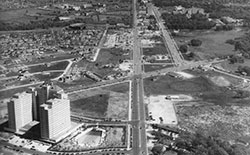The Texas Medical Center (1981-2002, Section 10)
The Texas Medical Center continued to expand at the end of the twentieth century. Located in Houston, the TMC contained 46 not-for-profit, medicine-related institutions as of 2007, including 13 hospitals and two specialty institutions, two medical schools, four nursing schools, and schools of dentistry, public health, pharmacy, and other health-related careers. More heart surgeries are performed at the TMC annually than anywhere else in the world. TMC receives more than 5.5 million annual patient visits, including more than 10,000 international patients. It employs 73,500 people, including 4,000 physicians and 11,000 nurses at its 46 institutions.
Institutions within the TMC continue to undergo changes. In January 1990, a newly constructed 578-bed, Ben Taub General Hospital replaced the old facility. Owned and operated by the Harris County Hospital District, the six-floor facility covers 755,000 square feet.
The Memorial Hermann Healthcare System is building a Heart & Vascular Institute building on its long established expertise in these fields. Baylor College of Medicine opened a new adult outpatient center in 2005.
In 1993, the University of Texas M.D. Anderson Cancer Center launched a $250 million expansion project that added some 500 beds, two research facilities, an outpatient clinic, and other buildings. Its Proton Therapy Center opened in 2006. Offering the most advanced cancer treatments, it is the largest such facility in the world.


